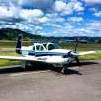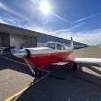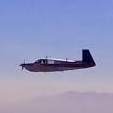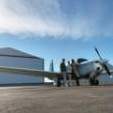All Activity
- Past hour
-
Agree with @EricJ. You are looking at an enormous spend. You will be much better off spending 100K on an actively flying, well maintained plane with decent avionics instead of pumping at least that much, likely much more, into your $45K purchase and still facing all the hidden gremlins, some of which may permanently ground the plane faster than you can say "annual".
-
Mooney Lycoming riveted turbo v clamp.
flyboym20m replied to flyboym20m's topic in Modern Mooney Discussion
After several hours of searching l finally found the m20m riveted clamp at aircraft spruce. They have 5 available @ $1695.00 -
DGHSDFGS joined the community
-
kortopates started following 201 Gear Up at KDWH
-
This one might be a project for a very bored A&P that just wants to take a risk on it, but it'll need radios/etc., plus all of the hidden stuff, plus the risk on the engine, etc., etc. $80k-$100k for the panel work alone, plus everything else. There is unlikely to be much value there if you started with it for free. For less than the money and time that would need to be put into this one a very nice currently flying airplane could be had.
-
I bought my first Mooney 2 years ago, and went over my "airplane budget" to do so. I looked at a lot of cheaper planes that needed a little TLC and almost pulled the trigger on a couple. Ultimately, I'm incredibly happy that I ended up spending a little more on the initial purchase to get something that was "turn key". I'm two uneventful annuals in and very few little/unexpected fixes in between. I read ALL the forums on here while shopping and ultimately decided on the "buy your forever plane first" route and I can't imagine doing it any other way now.
-

Help settle marital paint scheme dispute!
Ragsf15e replied to emillerslo's topic in Modern Mooney Discussion
I thought of your “dispute” when I saw this yesterday. I say you’re a lucky man with first world problems. Apparently it could be much worse… -
Knots2U has couple of new parts, call Lasar, whatever they do not have they will know where to find, some parts may be worth repairing others are best used as drill templates, ABS gets brittle, rattles and may just crack somewhere else, depends also on how much time you want to spend
-

Looking at Buying Unairworthy M20J for $45k
Greg Ellis replied to Ted_G's topic in General Mooney Talk
I think I agree. I just do not see a price that this thing will sell as one piece. But, it does seem to have some possible parts that would fetch some money. For instance, the whole control yoke complex for someone with an older model wanting to upgrade to newer style yokes. The interior seems to be in okay condition even though it looks like the carpet is missing. The prop may still be okay (0 time but sitting outside for a long time) etc, etc.... - Today
-
all very candid remarks, value of the plane is salvage, unless you are retired and an A&P IA and have done this kind of project before stay away and find an airplane that is ready to go
-

Logbook Page Removed and not Disclosed - Criminal Misrepresentation?
Hank replied to M20GforMe's topic in General Mooney Talk
3.7 hours may be realistic for someone who has never done it before. They must have misplaced this decimal just like on the hourly rate for dipstick work. -
Looking at Buying Unairworthy M20J for $45k
Paul Thomas replied to Ted_G's topic in General Mooney Talk
I think it's been on the market for almost a year; I thought it had sold. As much as it pains me to say, I think the value in this one is a part out. -
I am training in NJ but will be relocating to VA when I am 100% retired I did not know what a Mooney was until about 6 months ago when I saw them at the airport I train at. My instructor filled me in on them as well as other Pilots at the airport. I did not have the time to train since I ran my own business for 32 years and have a disabled son (Autism) who needed care. My son transitioned to a group home last year and is doing well there, so that freed up time for my wife and myself to explore our interests. Took a intro flight in a 172 with my wife and we loved it. I am a car guy/mechanic and restored a bunch of AMC cars, so Airplanes looked like a nice upgrade to spruce up and run!
-
Thank you Skip. SB 208 will be logged since it is now done, I just need to get the logs to my IA. I had not thought about a quart of SEM paint but that makes the job so much easier when I already have all the spray equipment.
-
Vantage or fix what you have. Is it still ABS plastic for a 1990 interior? IF so, ABS cement is magic to fix cracks... add some cloth and it's like working with epoxy except it's easier (and better since you're effectively welding the existing ABS). Jeager Interior also has a do it yourself guide with ton of great information. I was given a ton of good advice: https://mooneyspace.com/topic/51672-overhead-console-replacement/#comment-920451
-
Incredibly exciting for you ! Enjoy every aspect.
-
It's like the Warrior.
-
Great point. First, it's a satisfaction you will have earned, and you should be pretty comfortable in that plane. Second, it will begin the eye-opening practical process of aeronautical decision-making.
-
Hello, I’m looking to find interior plastic side pieces for my Bravo. It’s a 1990 that sat outside for a bit I believe and the interior plastic side pieces are cracked and broken. If anyone has any leads on a used set that would be appreciated.
-
I don't think this plane will fly again
-
That lead time from Continental is for a new or rebuilt -LB engine and exchanging my -GB as a core. The overhaul shops I asked said I would be on my own to come up with the clamps once they converted it to an -LB. And given that I have an airmelt crankshaft, the price of an OH would be pretty close to a factory engine anyway. I had assumed that Continental was using the RAM clamps which would explain why they only got approvals for the engines you can still buy. That being said, I got a call from the shop that has my plane just now and the clamps no longer leak after they removed and reinstalled the exhaust to replace some exhaust gaskets that were also leaking. So if it weren't for the fact that I also had them pull the prop and governor for IRAN/Reseal, I am actually safe and legal to fly the plane home for exactly 1.2 more tach hours until the 50-hour AD applicability kicks in. I guess I can at least get it out of hail danger now so I'm super excited.
-
Well, it should be. This happened to me in Canada, and the Canadian mechanics immediately figured out that the quick drain was leaking. But they also found that a fairly large piece of rubber gasket material was swimming around in the oil, and managed to plug the intake hole of the quick drain. So the engine still had about 2 1/2 quarts of oil, it was not completely dry. The OP got to 4 psi because I throttled the engine to idle to try to save it in case I needed a little power to make it to the runway, and also because I tipped the nose over fairly sharply because I had to dive about 18,000 feet quickly to avoid being blown over Lake Huron by tailwinds. Tipping the nose over causes the oil to run away from the pump intake. It was not unexpected, but still tightened the sphincter muscles. So the Canadian mechanics felt they did not have to disassemble the engine. Unfortunately, the steep unpowered dive caused some piston slap and within a couple hundred hours I had the entire engine IRANd, which is probably what should have happened right away.
-
No, I did not use the chart to arrive at my setting. These are true numbers. I should add that I arrived at the setting with my old engine, I now have a new engine and am finding that it wants a little less fuel flow. Around 10.9, but otherwise the same. I am still working out the numbers for the new engine though. I derived the old numbers with fairly exhaustive testing using the individual EGTs, the idea being to keep the EGT that is nearest to peak, far enough away from peak for engine health. Once I know how that worked, I just use TIT. I keep my TIT at or under 1600 (the max is 1650). In the old engine I found that if TIT got over that number by very much it had a tendency to continue rising. I use a little flex in the number, in other words if the TIT is 1609 or something in that vicinity and is stable (is not continuing to rise) I am ok with that. The new engine is very slightly hotter than the old, either that or I am doing the testing in mostly summer conditions. The idea behind the 34" MP number is that lean of peak is an air/fuel ratio. The "perfect" ratio is known as stoichiometric mix. It is that mix where all of the O2 and all of the fuel is consumed in the combustion process. I put "perfect" in quotes because while it would seem to be ideal, it results in the highest Internal Cylinder Pressures and the hottest CHTs, which are hard on the engine. What you are trying to do with either lean of peak or rich of peak, is slow the combustion cycle, which lowers the ICP and CHT. In the case of lean of peak you are doing that by supplying the engine with a mixture that has more air than can be consumed by the available fuel. There are two ways to do that with a turbocharged engine. Either you leave the MP at a fixed setting and reduce the fuel, or you set the fuel at a specific number and increase the MP, which increases the air (O2) being introduced and thus makes the mixture leaner than stoichiometric. I was initially concerned that would be hard on the turbo, but the turbo in the old engine made it well over 1,000 hours without a problem. The percent power is about 70-71%. Percent power when lean of peak is determined by the formula 13.7 x fuel flow in GPH/rated HP (210). Please note that the 231 power controls are different from virtually every other aircraft because the wastegate controller is not automatic, in other words you can't set the MP to, say, 34", and then roll the fuel flow back to 11 GPH and watch your engine monitor to see where the peak is. The classic manner of making this setting, as I said earlier, is to either hold the fuel flow at a fixed setting and increase the MP, or hold the MP at a fixed number and decrease the fuel. But there is an interlink between the MP and fuel flow in the 231 engine, so a change in one parameter will change the other parameter. In effect you change the entire power setting if you do that and you are not affecting the air/fuel ratio much if at all. What I do to get to this setting is takeoff full rich, 36" and climb to altitude without changing anything except to adjust the MP up as I climb to maintain 36. Then at cruise altitude I reduce the MP to around 34-35" followed by reducing the RPMs to 2450. As you reduce the RPMs the MP will reduce so once you get the RPMs to 2450 you need to adjust the MP back up to around 34". Then reduce the fuel flow from wherever it is to your desired setting, say 11.0 GPH. Then you will once again need to adjust the MP to get to 34". In the first ten minutes or so of flight at this setting you need to watch the setting carefully, because the aircraft will speed up and so will the turbocharger, so you need to stay on top of that and keep the MP at 34 and the fuel flow at, say 11. Then periodically check the power setting during your flight to make sure it is staying where you want it. The 231 system is very analog, it takes awhile to settle in where you want it, and any changes that happen in ambient conditions will affect the power setting. That's what I do. YMMV
-
Looking for an M20C CFI near Grand Junction / Montrose, CO
oisiaa replied to oisiaa's topic in West Coast Mooney Club
Thanks, I'll look there, but also open to replies here too. -
100k is wishful thinking. paint alone will be 30k+. the have to's are bad enough, when the "while we are there's" it will go to 200 in the blink of an eye.
-
JPI USB Download Box $99 plus shipping
Aerodon replied to Aerodon's topic in Avionics / Parts Classifieds
yes, have more than one.











